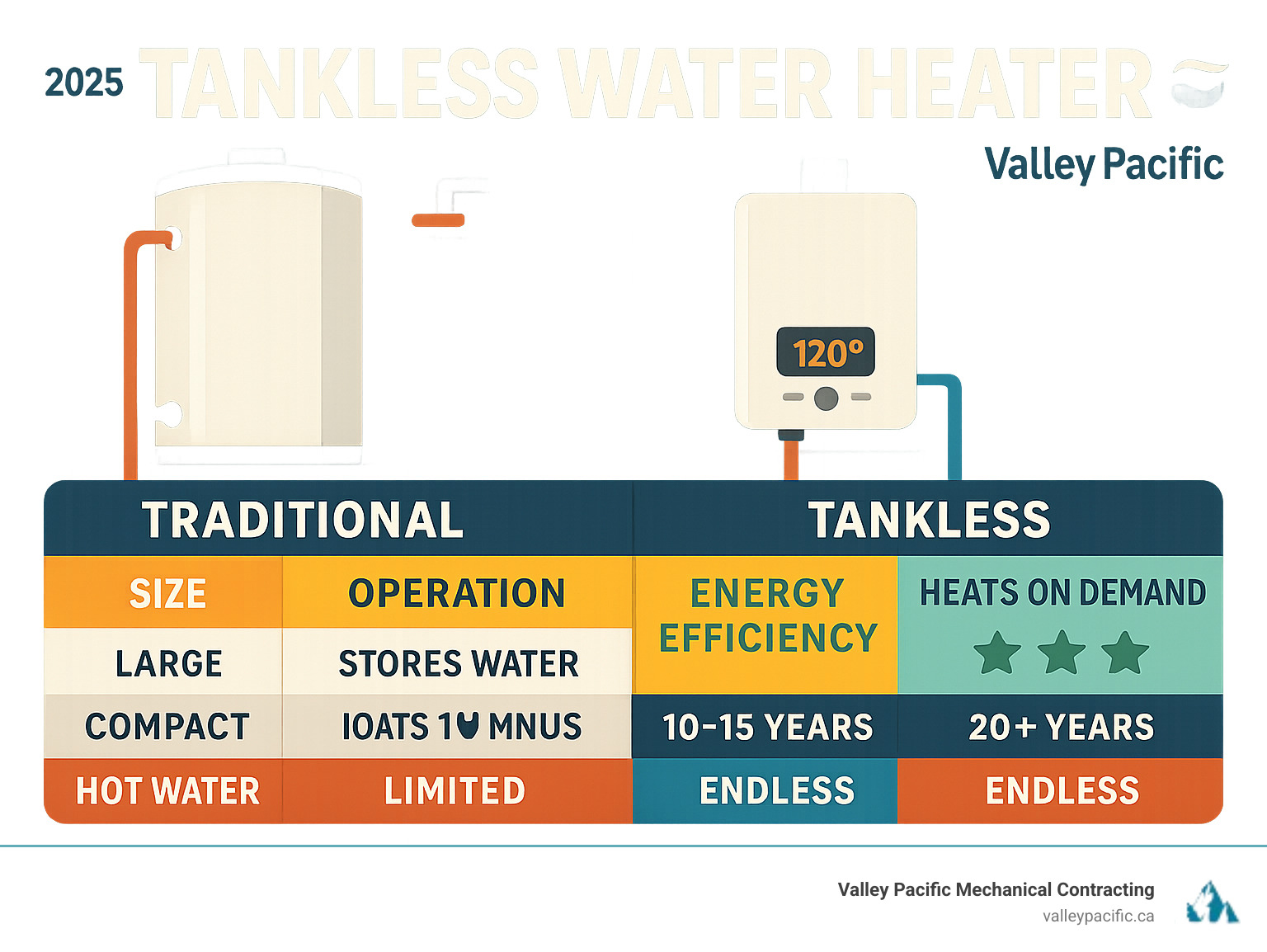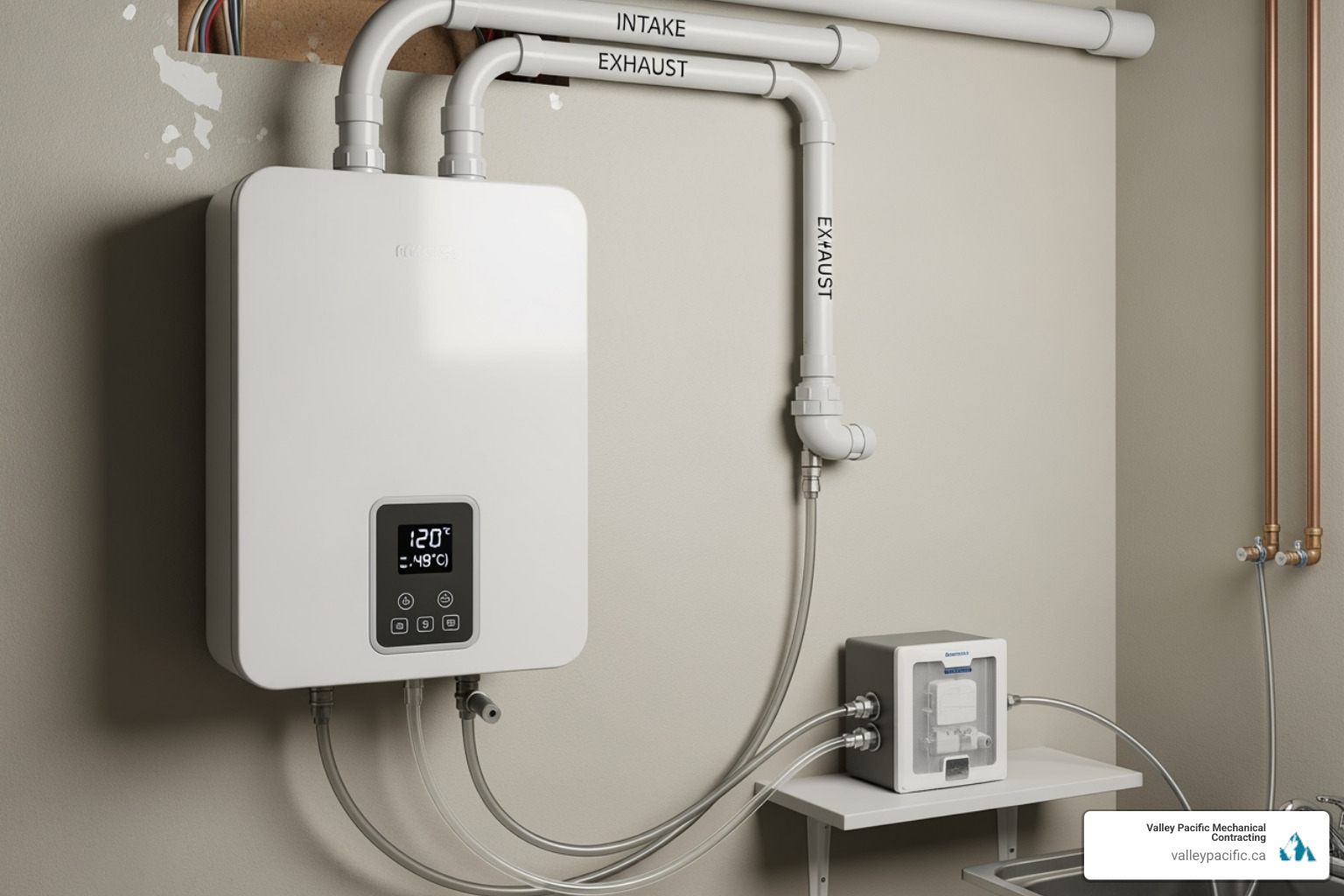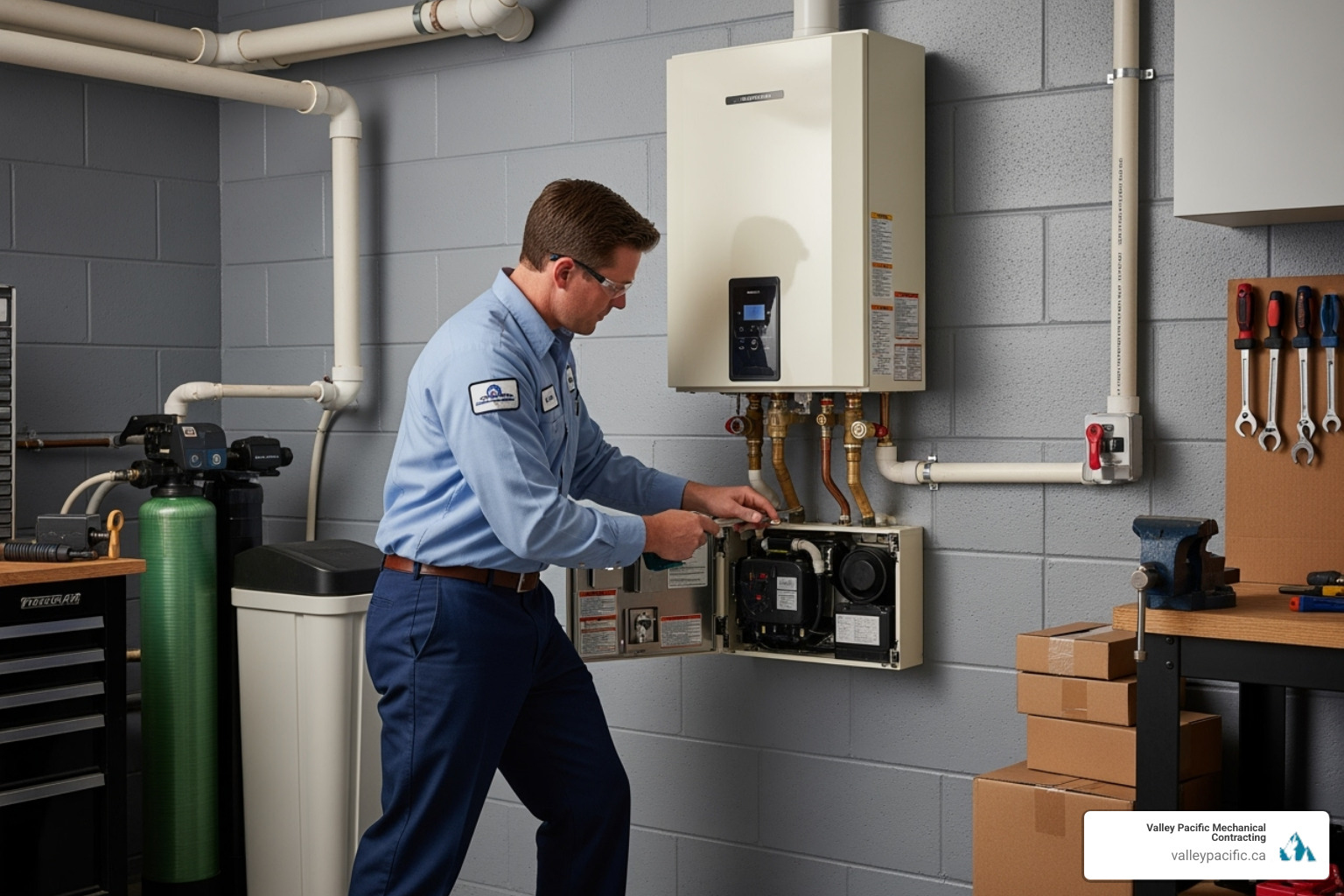Never Run Out of Hot Water Again: Exploring Tankless and Traditional Options


Why Every Homeowner is Talking About Tankless Water Heaters
A tankless water heater heats water on demand using a heat exchanger, eliminating the need for a storage tank and providing continuous hot water while reducing energy consumption through the elimination of standby heat losses.
Key advantages of tankless systems:
- On-demand heating - Hot water whenever you need it
- Space-saving design - Wall-mounted units free up floor space
- Energy efficiency - No standby heat loss like traditional tanks
- Longer lifespan - Typically 20+ years vs. 10-15 years for tank heaters
- Endless supply - Never run out during back-to-back showers
Main considerations:
- Higher upfront installation requirements
- Flow rate limitations during simultaneous use
- Potential home upgrades (gas lines, venting, electrical)
Frustrations like cold showers or a flooded basement from a failed tank heater are leading more homeowners to explore tankless options. While traditional heaters constantly reheat a large tank of water, tankless water heaters heat water instantly as it flows, using energy only on demand. This key difference impacts your utility bills, available space, and daily convenience. Choosing the right system means matching the technology to your household's needs, infrastructure, and long-term goals.

Tankless water heater terms at a glance:
Understanding Your Hot Water: Tank vs. Tankless Heaters

Your home's water is heated by one of three main systems: the traditional storage tank, the modern tankless water heater, or the eco-friendly heat pump water heater. A traditional storage tank keeps 40-80 gallons of water constantly hot, leading to standby heat loss from reheating unused water. A tankless water heater takes a different approach, heating water instantly on demand. Then there's the heat pump water heater, which cleverly moves heat from the surrounding air into the water, making it incredibly energy-efficient.
Here's how these three stack up against each other:
| Feature | Storage Tank | Tankless Water Heater | Heat Pump |
|---|---|---|---|
| Energy Use | High standby loss, heats continuously | No standby loss, heats on demand | Very efficient, uses ambient heat |
| Lifespan | 10-15 years | 20+ years | 10-15 years |
| Space | Bulky floor unit | Compact wall-mounted | Large, needs conditioned space |
| Hot Water Supply | Limited by tank size | Continuous flow (when sized right) | Limited by tank, slower recovery |
How a Tankless Water Heater Works
A tankless water heater works on an instant response system. When you turn on a hot tap, a flow sensor activates a powerful heat source—either a gas burner or an electric element. This heats a heat exchanger that warms the water as it passes through. The unit modulates its power to maintain a consistent temperature and shuts off instantly when the tap is closed. Gas models use a sealed venting process to safely exhaust fumes.
Key Differences from Traditional Tanks
The operational differences between tankless and tank heaters significantly impact your home. Energy consumption is the biggest differentiator. By eliminating standby loss, tankless water heaters are 8-34% more energy-efficient, depending on your household's water usage. In terms of lifespan, tankless units typically last over 20 years, far exceeding the 10-15 year lifespan of traditional tanks. The physical footprint is another major advantage; compact, wall-mounted tankless units free up valuable floor space. However, there's a trade-off in hot water capacity. A tankless heater provides an endless supply but is limited by its flow rate (GPM). Simultaneous use of multiple hot water fixtures can strain the system if it's not sized correctly.
Choosing Your Ideal Tankless Water Heater: A Sizing and Selection Guide
Choosing the right tankless water heater is about matching the unit to your home's specific needs. Sizing isn't about tank volume; it's about calculating your peak hot water demand. Factors include how many fixtures run simultaneously and even your local climate, as colder groundwater requires more heating power.

In the Lower Mainland, we're fortunate to have relatively moderate groundwater temperatures, but winter can still bring some chilly surprises that affect your tankless water heater's performance.
How to Size Your New Tankless Water Heater
Sizing a tankless water heater involves two key calculations: flow rate and temperature rise.
1. Calculate Peak Flow Rate (GPM): Add up the GPM of all fixtures you might use at the same time during your busiest period.
- Showerheads: 1.5 to 2.5 GPM
- Kitchen faucets: 1.5 to 2.2 GPM
- Bathroom faucets: 0.5 to 1.5 GPM
- Dishwashers: 1.0 to 2.5 GPM
- Washing machines: 1.5 to 3.0 GPM
- Bathtub fillers: 4.0 GPM or higher
For example, a peak scenario of a shower (2.0 GPM) and a dishwasher (1.5 GPM) would require a unit that can handle at least 3.5 GPM.
2. Determine Temperature Rise: This is the difference between the incoming cold water temperature and your desired hot water output (typically 120°F). In winter, with 50°F groundwater, you'd need a 70°F temperature rise.
You then match your required GPM and temperature rise to a unit's specifications. Higher BTU ratings provide more heating power for higher demand and colder climates. Also, note that some units require a minimum flow to activate, which may be an issue with ultra-low-flow fixtures.
Gas vs. Electric: Which Fuel Source is Right for You?
The choice between gas and electric often depends on your home's existing utilities.
Natural gas units are the workhorses for tankless systems, offering higher flow rates ideal for larger families and cold climates. They are highly efficient but often require upgrading your gas line to meet their high BTU demand (up to 199,000 BTU). Propane offers similar performance for homes without natural gas service.
Electric tankless water heaters are a great solution where gas is unavailable or venting is difficult. Installation is simpler, but they typically have lower flow rates than gas units and require significant electrical power, often needing dedicated 240V circuits and a panel upgrade. For high-demand homes, multiple electric units may be necessary.
Condensing vs. Non-Condensing Technology
When looking at gas-fired tankless water heaters, you'll choose between condensing and non-condensing models.
Non-condensing units are simpler and less expensive upfront but are less efficient (around 0.82 UEF). They vent extremely hot exhaust, requiring costly stainless steel venting.
Condensing units are the efficiency champions (0.95+ UEF) and our usual recommendation. They use a secondary heat exchanger to capture more heat from the exhaust. This cools the gases enough to allow for inexpensive PVC venting, which helps offset the higher unit cost. While they require a condensate drain, the long-term energy savings and cheaper venting make them the superior investment for most homeowners.
Installation and Performance: What to Expect from Your System
Proper installation is critical for a tankless water heater and is not a DIY project. A licensed professional is essential for handling the complex plumbing, gas, venting, and electrical work.

Your home may need several upgrades:
- Gas Line Upsizing: Tankless units have high BTU demands that often require a larger gas line.
- Electrical Circuits: Even gas models need electricity for their controls, and electric models require dedicated high-amperage circuits.
- Venting: Requirements depend on the model. Condensing units can use PVC piping, while non-condensing units need expensive metal venting.
- Condensate Drain: Condensing models produce acidic condensate that requires a proper drain.
- Combustion Air: Gas units need adequate fresh air for safe operation.
For homeowners dealing with more complex mechanical systems, our team brings over 30 years of expertise to ensure everything works seamlessly together. More info about our boiler installation services.
Hot Water Recirculation Explained
A recirculation system solves the common complaint of waiting for hot water in larger homes. It keeps hot water in the pipes, providing it almost instantly. Options include dedicated return lines for maximum efficiency or crossover valves that use existing cold water lines as a budget-friendly alternative. Demand-based controls (timers, buttons, smart controls) activate the system only when needed, saving energy. The comfort and water conservation benefits are significant, especially when pipes are well-insulated.
Common Performance Considerations
Understand these common traits of tankless systems:
- "Cold water sandwich": A brief burst of cold water may occur when you quickly turn a tap off and on again.
- Minimum flow rate: The unit needs a certain flow (e.g., 0.5 GPM) to activate, which can be an issue for some low-flow fixtures.
- Simultaneous use: Exceeding the unit's GPM capacity by running too many fixtures at once can cause water temperature to drop. Proper sizing prevents this.
- Noise levels: Gas units produce some fan and burner noise. Placement is key to minimizing sound.
- Power outages: Even gas units need electricity to operate. A battery backup or generator is required for hot water during an outage.
Long-Term Value: Maintenance, Lifespan, and Efficiency
A tankless water heater is a long-term investment, with an expected lifespan of over 20 years—often double that of a traditional 10-15 year tank heater. This durability is backed by long manufacturer warranties, typically 10-15 years on the heat exchanger.
However, longevity depends on maintenance and water quality. Hard water can cause mineral scale to build up in the heat exchanger, reducing efficiency and causing damage. For homes with hard water, a water softener is an essential part of protecting your investment. The U.S. Department of Energy confirms that you can save on energy costs with a tankless water heater, with significant annual savings possible depending on usage.

Essential Maintenance for Your Tankless System
To ensure a long life for your tankless water heater, regular maintenance is key.
- Annual Descaling: This is the most critical task. Flushing the heat exchanger with a descaling solution removes mineral buildup (scale), which is vital in areas with hard water. While DIY kits are available, professional service is recommended.
- Clean Intake Filters: Periodically check and clean the sediment filter on the cold water inlet to ensure proper flow and protect the unit.
- Inspect Vents and Connections: Regularly check that all water, gas, and vent connections are secure and that the vent path is clear of obstructions.
Understanding Efficiency and Savings
Modern efficiency is measured by the Uniform Energy Factor (UEF)—a higher rating means greater savings. Tankless water heaters save money by eliminating standby heat loss and only using energy when you need hot water. You can increase savings further by insulating your hot water pipes, which reduces heat loss as water travels to your faucet. Realistic savings depend on your water usage, energy costs, and the efficiency of your old system.
Frequently Asked Questions About Water Heaters
Over our 30+ years serving the Lower Mainland, we've heard just about every water heater question imaginable. These are the questions that come up time and again.
Are rebates or tax credits available for upgrading my water heater?
Yes, significant rebates and tax credits are often available for high-efficiency water heaters. Start by looking for ENERGY STAR certified models. Check for current incentives from your local utility provider, like FortisBC, and provincial programs such as CleanBC. These programs can often be combined for greater savings. Crucially, always confirm that your chosen model is eligible for the rebate before you purchase it.
Will a tankless water heater work with a well system?
Yes, but your well must provide consistent water pressure and a sufficient flow rate (typically over 0.4 GPM) for the unit to operate correctly. Because well water can contain sediment, installing a sediment filter before the heater is essential to prevent clogs. We also recommend testing for water hardness, as a water softener may be needed to prevent scale buildup. A professional assessment of your well system is the best way to ensure compatibility.
What are the environmental benefits of different water heaters?
Your water heater choice has a real environmental impact.
- Traditional Tank Heaters: These are the least efficient due to constant standby heat loss, which wastes energy.
- Tankless Water Heaters: By heating water only on demand, they significantly reduce energy consumption. Their longer lifespan (20+ years) also means less landfill waste.
- Heat Pump Water Heaters: These are the most environmentally friendly, especially when powered by clean electricity like BC's hydro power. They move heat from the air to the water, making them exceptionally efficient.
A high-efficiency tankless water heater is a major environmental upgrade over a traditional tank, and a heat pump model can be even greener.
Your Partner for Endless Hot Water in the Lower Mainland
Switching to a tankless water heater offers long-term comfort and efficiency, including endless hot water, energy savings, and more space. However, these benefits depend entirely on proper sizing and expert installation. An incorrectly sized unit can lead to lukewarm showers, while improper installation can cause serious safety and performance issues.
That's where Valley Pacific Mechanical Contracting makes the difference. For over 30 years, we've provided homeowners throughout Mission, Maple Ridge, Langley, Pitt Meadows, and Coquitlam with expert guidance. We don't just sell you a unit; we assess your home's infrastructure and your family's water usage to recommend the perfect system.
Our certified technicians handle every detail, from gas line upgrades to flawless venting, ensuring your tankless water heater performs perfectly. With our 24/7 emergency service and "headache-free" approach, you get the peace of mind that comes from three decades of expertise.
Ready to explore how a tankless water heater could transform your home's hot water experience? For expert advice on the best heating solution for your home, explore our heat pump services and find how we're helping Lower Mainland families create more comfortable, efficient homes every day.








